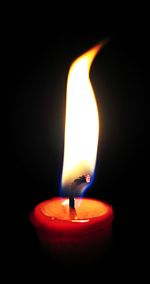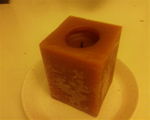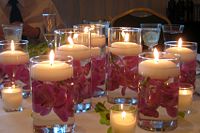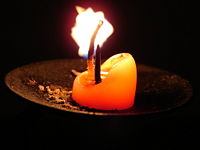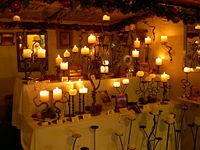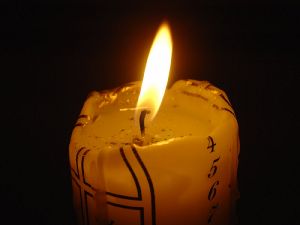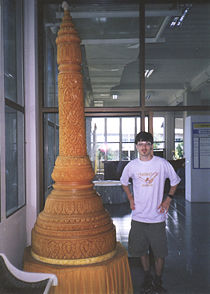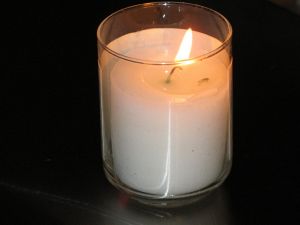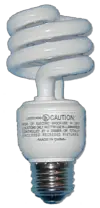Candle
A candle (from the Latin word candere, meaning "to shine") is a light source that usually has an internal wick rising through the center of a column of solid fuel. Prior to the mid-nineteenth century, candles were frequently made from tallow, a by-product of beef-fat rendering. Modern fuel is nearly always some form of wax, with paraffin wax being the most common. Candles made from gel, soy, beeswax, and vegetable products are also available. A candle manufacturer is traditionally known as a chandler. Various devices have been invented to secure candles into place, from simple tabletop candle holders, to elaborate chandeliers.
With the advent of kerosene lamps and electric lights, candles are seldom used for lighting dark areas. Rather, they are used mainly for aesthetic purposes and religious worship. In the latter case, the light of the candle is often taken to represent internal, spiritual enlightenment, or the light of truth. Scented candles are used in aromatherapy.
Principles of candle burning
Prior to the candle being ignited, the wick is saturated with the fuel in its solid form. The heat of the match or other flame being used to light the candle first melts and then vaporizes a small amount of the fuel. Once vaporized, the fuel combines with oxygen in the atmosphere to form a flame. This flame then provides sufficient heat to keep the candle burning via a self-sustaining chain of events: The heat of the flame melts the top of the mass of solid fuel, the liquefied fuel then moves upward through the wick via capillary action, and the liquefied fuel is then vaporized to burn within the candle's flame.
The burning of the fuel takes place in several distinct regions (or zones, as evidenced by the various colors that can be seen in the candle's flame). In the bluer, hotter regions, hydrogen is being separated from the fuel and burned to form water vapor. In the brighter, yellower part of the flame, the remaining carbon is being oxidized to form carbon dioxide.
As the mass of the solid fuel is melted and consumed, the candle grows shorter. Portions of the wick that are not evaporating the liquid fuel are, ideally, consumed in the flame, limiting the exposed length of the wick and maintaining a roughly stable temperature and rate of fuel consumption. Some wicks require manual trimming with scissors or a wick trimmer for even burning.
History
Candle making was developed independently in many countries throughout history. The early candle was made from various forms of natural fat, tallow, and wax.
3000-1 B.C.E.
The Egyptians and Cretans made candles from beeswax as early as 3000 B.C.E.[1]
In addition, clay candle holders found in Egypt date back to 400 B.C.E.[2]
In early China and Japan, tapers were made with wax from insects and seeds, wrapped in paper.[3]
Qin Shi Huang (259–210 B.C.E.) was the first emperor of the Chinese Qin Dynasty (221–206 B.C.E.). His mausoleum, which was rediscovered in the 1990s, twenty-two miles east of Xi'an, contained candles made from whale fat.
In India, wax from boiling cinnamon was used for temple candles.[3]
1-1500 C.E.
In Rome, around the first century, candles were made out of tallow and the pith of rushes.
There is a fish called the eulachon or "candlefish," a type of smelt that is found from Oregon to Alaska. During the first century C.E., indigenous people from this region used oil from this fish for illumination.[3] A simple candle could be made by putting the dried fish on a forked stick and then lighting it. In Rome, they used tallow, derived from suet, a crumbly animal fat to make their candles. Although the tallow was extremely smoky, the smoke was forgiven for light and used for prayer. They were used at altars, shrines, and in temples and were very common. The technique was simple; the tallow was put into the melting pot, then poured into molds made of bronze. A trough underneath would catch the excess wax and return it to the melting pot. For the wick, hemp, usually made from the pith of rushes, (the tissue inside the stem of a plant that grows in marshes) is suspended from a horizontal rod over the mold when the tallow is poured in.
Excavations at Pompeii, Italy, revealed several candelabra.
In Europe, the earliest surviving candle was discovered near Avignon in France, from the first century C.E.[1]
- Candle manufacture
The oldest candle manufacturers still in existence are Rathbornes Candles, founded in Dublin in 1488.
- Candles for timekeeping
Anglo-Saxon king Alfred the Great (c. 849-899) used a candle-clock that burned for four hours. There were lines around the side to show the passing of each hour.[4] Later, 24-hour candles were invented based on the same concept.[5] The Sung dynasty in China (960–1279) also used candle-clocks.[6]
1500 C.E.-present
During the Middle Ages in Europe, the popularity of candles is shown by their use in Candlemas and Saint Lucy festivities. Tallow, fat from cows or sheep, became the standard material used in candles in Europe. The Tallow Chandlers Company of London was formed in about 1300 in London, and in 1456 was granted a coat of arms. Dating from about 1330, the Wax Chandlers Company acquired its charter in 1484. By 1415, tallow candles were used in street lighting. The trade of the chandler is also recorded by the more picturesque name of "smeremongere," since they oversaw the manufacture of sauces, vinegar, soap, and cheese. The unpleasant smell of tallow candles is due to the glycerin they contain. For churches and royal events, candles from beeswax were used, as the smell was usually less unpleasant. The smell of the manufacturing process was so unpleasant that it was banned by ordinance in several cities. The first candle mold comes from fifteenth century Paris.
The first American colonists discovered that bayberries could be used to make candles, but the yield was very poor. Fifteen pounds of boiled bayberries would provide only one pound of wax.[7]
By the eighteenth century, the Chinese designed weights into the sides of candles; as such a candle melted, the weights fell off and made a noise as they fell into a bowl.
In 1750, spermaceti, oil produced by the sperm whale, was used to make a very expensive candles. By 1800, a much cheaper alternative was discovered. Colza oil, derived from Brassica campestris, and a similar oil derived from rape seed, yielded candles that produce clear, smokeless flames. The French chemists Michel-Eugene Chevreul (1786–1889) and Joseph-Louis Gay-Lussac (1778–1850) patented stearin, in 1811. Like tallow, this was derived from animals but had no glycerin content.
Candle manufacture
Joseph Sampson was granted a United States patent for a new method of candle making in 1790 (this was the second patent ever granted by the U.S.).[8]
In 1834, Joseph Morgan began to industrialize the production of candles. He invented a machine to manufacture 1,500 per hour, from a mold.[9]
A chemist named Auguste Laurent distilled paraffin from schist in 1830. Another chemist, Jean Baptiste Dumas, obtained paraffin from coal-tar in 1835. Not until 1850 did paraffin become commercially viable, when James Young filed a patent to produce it from coal.[10] The use of paraffin revolutionized candle-making, as it was an inexpensive material that produced a high-quality, odorless candle that burned in a reasonably clean manner.
Kerosene's impact on candle making
Despite the advances in candle making, the industry was devastated soon after by the distillation of kerosene (confusingly also called paraffin oil or just paraffin). Kerosene is an excellent fuel for lamps, producing bright light. From that point, the candle became more of a decorative item. Recently resin-based candles that are freestanding and transparent have been developed, with the claim that they burn longer than traditional paraffin candles.
In 1829, William Wilson of Price's Candles invested in 1,000 acres (4 km²) of coconut plantation in Sri Lanka.[11] His aim was to make candles from coconut oil. Later, he tried palm oil from palm trees. An accidental discovery swept all his ambitions aside when his brother George Wilson distilled the first petroleum oil in 1854. In 1919, Lever Brothers purchased Price's Candles and in 1922, a joint-owned company called Candles Ltd. was created. By 1991, the last remaining owner of Candles Ltd was Shell Oil Company, which sold off the candle-making part of its business.
Candles for timekeeping
A form of candle-clock was used in coal-mining until the twentieth century.
Fuel and candle holders
The candle can be made of paraffin (a byproduct of petroleum refining), stearin (now produced almost exclusively from palm waxes), beeswax (a byproduct of honey collection), gel (a mixture of resin and mineral oil), some plant waxes (generally palm, carnauba, bayberry, soy), or tallow (rarely used since the introduction of affordable wax alternatives). The candle is produced in various colors, shapes, sizes, and scents.
The most basic production method generally entails the liquefaction of the solid fuel by the controlled application of heat. This liquid is then poured into a mold to produce a pillar type candle, a fireproof jar to produce a candle container, or a wick is repeatedly immersed in the liquid to create a dipped taper. Often, fragrance oils are added to the liquid wax prior to pouring. Natural scents, in the form of essential oils, can be used, but these are usually only found in a premium candle. The candle may also be colored by the addition of some sort of coloring agent. In practical terms this is almost always an aniline-based dye, although pigments can be used in some circumstances.
A candle typically produces about 13 lumens of visible light and 40 watts of heat, although this can vary depending primarily on the characteristics of the candle wick. For comparison, note that a 40 watt incandescent light bulb produces approximately 500 lumens for the same amount of power. The modern SI unit of luminous intensity, the candela, was based on an older unit called the candlepower, which represented the luminous intensity emitted by a candle made to particular specifications (a "standard candle"). The modern unit is defined in a more precise and repeatable way, but was chosen such that a candle's luminous intensity is still about one candela.
It is commonly believed that the candle made of beeswax and/or soy burns more cleanly than petroleum based paraffin waxes. However, highly refined paraffin wax can burn at least as cleanly (with regard to particulates created during combustion) as natural waxes. The type of wick and inclusion of any scents and/or dyes have a much greater impact on the release of compounds, particulates, and smoke, regardless of the base material. The cleanest burning candle will therefore be unscented, undyed, and a well constructed candle burning in a draft free area. Furthermore, a candle will function well when formulated waxes are blended together (soy, paraffin, and other waxes) and fragrance oils along with wick selections are balanced properly.
A smoke film can be a concern to those who frequently burn a candle indoors and is also referred to as ghosting, carbon tracking, carbon tracing. Smoke can be produced when a candle does not burn the wax fuel completely. A scented candle can be a source of candle smoke deposits. Trimming candle wicks to about 6 millimeters (¼ in) or shorter is recommended to keep smoking at a minimum. A flickering flame will produce more smoke, therefore a candle should be burned in an area free from drafts.[12]
Additional debate on the use of wax in a candle exist on what is "natural." Proponents of the soy wax candle will note the material is biodegradable and "all natural." However, most soy beans that result in the ultimate manufacture of soy wax in the candle are genetically modified. Paraffin wax, as used in candle making, is also biodegradable. It also often meets the United States Food and Drug Administration's criteria for use in foods and in contact with food.
Decorative candle holders, especially those shaped as a pedestal, are called candlesticks; if multiple candle tapers are held, the term candelabrum is also used. The root form of chandelier is from the word for candle, but now usually refers to an electric fixture. The word chandelier is sometimes now used to describe a hanging fixture designed to hold multiple tapers.
Many candle holders use a friction-tight socket to keep the candle upright. In this case, a candle that is slightly too wide will not fit in the holder, and a candle that is slightly too narrow will wobble. Any candle that is too large can be trimmed to fit with a knife; a candle that is too small can be fitted with aluminum foil. Traditionally, the candle and candle holders were made in the same place, so they were appropriately sized, but international trade has combined the modern candle with existing holders, which makes the ill-fitting candle more common.
Electric candle warmers are now being sold so that candle wax can be melted to release the fragrance without requiring an open flame.
General usage
Prior to the domestication of electricity, the candle was a common source of lighting, even when the oil lamp was available. Due to local availability and the cost of resources, for several centuries up to the nineteenth century the candle was more common in northern Europe, and olive oil lamps more common in southern Europe and around the Mediterranean Sea. Candle makers were known as chandlers.
Candles were also used to light fires.
Today, the candle is usually used for its aesthetic value, particularly to set a soft, warm, or romantic ambiance, and for emergency lighting during electrical power failures. The scented candle is common in aromatherapy.
Usage in timekeeping
With the fairly consistent and measurable burning of a candle, a common use was to tell the time. The candle designed for this purpose might have time measurements, usually in hours, marked along the wax. The Sung dynasty in China (960–1279) used candle-clocks. By the eighteenth century, candle-clocks were being made with weights set into the sides of the candle. As the candle melted, the weights fell off and made a noise as they fell into a bowl. A form of candle-clock was used in coal-mining until the twentieth century.
During the days leading to Christmas, some people burn a candle by a set amount to represent each day, as marked on the candle. The type of candle used in this way is called the "Advent candle," although this term is also used to refer to a candle that decorates an Advent wreath.
Usage in dance form
In some forms of raqs sharqi (belly dancing), candles may be used as a complementary element. The candles are either held on the dancer's hand or above her head, depending on the choreography.
Usage in religion
The candle is used in the religious ceremonies of many different faiths, some of which are noted here alphabetically.
Buddhism
Candles are a traditional part of Buddhist ritual observances. Along with incense and flowers, candles (or some other type of light source, such as butter lamps) are placed before Buddhist shrines or images of the Buddha as a show of respect. They may also be accompanied by offerings of food and drink. The light of the candles is described as representing the light of the Buddha's teachings, echoing the metaphor of light used in various Buddhist scriptures.[13] The Ubon Ratchathani Candle Festival is a Buddhist festival that makes extensive use of candles.
Christianity
In Christianity, the candle is commonly used in worship both for decoration and ambiance, and as symbols that represent the light of God or, specifically, the light of Christ. The candle is often placed on the altar. A votive candle may be lit as an accompaniment to prayer. The candle is lit by worshipers in front of icons in Orthodox and other churches. In some churches, a special candle known as the Paschal candle specifically represents Christ and is lit only at Easter, funerals, and baptisms.
In some Christian denominations, the day of Candlemas marks the end of the season of Epiphany. On this day, the presiding priest blesses the candle to be used in worship for the following year.
The candle was traditionally used to light Christmas trees before the advent of electric lights. They are still commonly used to decorate Christmas trees in Denmark and other European countries. They are also used in Advent wreaths.
In Sweden (and other Scandinavian countries), St. Lucia Day is celebrated on December 13, with the crowning of a young girl with a candle ring.
Hinduism
In almost all Hindu homes, lamps are lit daily before the altar of the Lord. In some houses, the lamps, or candles, are lit at dawn; in some, twice a day, at dawn and dusk; and in a few homes, they are maintained continuously.
A diya, or clay lamp, is frequently used in Hindu celebrations and forms an integral part in many social rites. It is a strong symbol of enlightenment and prosperity.
In its traditional and simplest form, the diya is made from baked clay or terracotta and holds oil that is lit by a cotton wick.
Traditional diyas have now evolved into a form in which waxes are used as replacements for oils.
Humanism
For some humanists, the candle has become a symbol of the light of reason or rationality. The Humanist festival of HumanLight often features a candle-lighting ceremony.
Judaism
In Judaism, the candle is traditionally lit on Friday evening at the start of the weekly Sabbath celebration and Saturday night during the Havdalah ritual, which ends the Sabbath.
The Jewish holiday of Hanukkah, also known as the Festival of Lights, is celebrated by lighting a candle in a special candelabrum (Chanukkiyah) each night during the eight-day holiday to commemorate the dedication of the altar in the Temple in Jerusalem. The candle was also used in remembering a deceased loved one, especially on their Yahrtzeit, the anniversary of their death according to the Hebrew calendar, when a 24-hour candle is lit. Similarly, on Yom HaShoah, a day of remembrance for all those who perished in the Holocaust, a candle is lit to honor the victims.
Kwanzaa
The Candle is also used in celebrations of Kwanzaa, which is an African American holiday which runs from December 26 to January 1. The kinara has three red, one black, three green.
Sikhism
The candle is used in Sikhism on Diwali.
Wicca
In Wicca and related forms of Neopaganism, the candle is frequently used on the altar to represent the presence of the God and Goddess, and in the four corners of a ritual circle to represent the presence of the four classical elements: Fire, Earth, Air, and Water. When used in this manner, lighting and extinguishing the candle marks the opening and closing of the ritual. The candle is also frequently used by Wiccans and other Neo-pagans for magical and meditative purposes.
Hazards
The candle can be a major cause of dangerous fires in households. (An electric candle warmer can be used to release fragrance without the risk of an open flame.)
The liquid wax is hot and can cause skin burns, but the amount and temperature are generally rather limited and the burns are seldom serious. The best way to avoid getting burned from splashed wax is to use a candle snuffer instead of blowing on the flame. A candle snuffer is usually a small metal cup on the end of a long handle. When placed over the flame the oxygen supply is cut off. They were used daily when the candle was the main source of lighting a home, before electric lights were available. Snuffers are available at most candle supply sources.
Glass candle holders are sometimes cracked by thermal shock from the candle flame, particularly when the candle burns down to the end.
A former worry regarding the safety of candles was that a lead core was used in the wicks to keep them upright in container candles. Without a stiff core, the wicks of a container candle could sag and drown in the deep wax pool. Concerns rose that the lead in these wicks would vaporize during the burning process, releasing lead vapors—a known health and developmental hazard. Lead core wicks have not been common since the 1970s. Imported candles may still be found to have some lead core wicks. Today, most metal-cored wicks use zinc or a zinc alloy, which has become the industry standard. Wicks made from specially treated paper and cotton are also available.
The hottest part of the flame is just above the very dull blue part to one side of the flame, at the base.
Notes
- ↑ 1.0 1.1 Ray T. Malbrough, The Magical Power of the Saints: Evocation and Candle Rituals (St. Paul, MN: Llewellyn Worldwide, 1998, ISBN 1567184561) p. 68.
- ↑ Acaysha, Show Me, Teach Me, Heal Me: A Beginner's Guide to Natural Answers (Victoria, BC: Trafford Publishing, 2004, ISBN 1412001315), p. 83.
- ↑ 3.0 3.1 3.2 Patricia Telesco, Exploring Candle Magick: Candle Spells, Charms, Rituals, and Divinations (Franklin Lakes, NJ: New Page Press, 2001, ISBN 1564145220).
- ↑ Eva Tappan, In the Days of Alfred the Great (Whitefish, MT: Kessinger Publishing, LLC, 2008, ISBN 0548811490).
- ↑ Gerhard Dohrn-van Rossum and Thomas Dunlap, History of the Hour: Clocks and Modern Temporal Orders (Chicago: University of Chicago Press, 1996, ISBN 0226155102).
- ↑ Silvio A. Bedini, The Trail of Time: Time Measurement with Incense in East Asia (Cambridge: Cambridge University Press, 1994, ISBN 0521374820), p. 54.
- ↑ Dorothy A. Mays, Women in Early America: Struggle, Survival, and Freedom in a New World (Santa Barbara, CA: ABC-CLIO, 2004, ISBN 1851094296), p. 438.
- ↑ Holland Thompson, Age of Invention: Chronicles of America (Whitefish, MT: Kessinger Publishing, 2004, ISBN 0766160130).
- ↑ Gordon Phillips, Seven Centuries of Light: The Tallow Chandlers Company (Cambridge: Granta Editions, 2004, ISBN 1857570642), p. 74.
- ↑ Tal Golan, Laws of Men and Laws of Nature: The History of Scientific Expert Testimony in England and America (Cambridge: Harvard University Press, 2004, ISBN 0674012860), p. 89-91.
- ↑ Michael Ball and David Sunderland, An Economic History of London, 1800-1914 (London: Routledge, 2001, ISBN 0415246911), p. 131-132.
- ↑ KSL Television & Radio, EPA Report: Candles & Incense. Retrieved June 24, 2008.
- ↑ Access to Insight, The Offerings, Lay Buddhist Practice. Retrieved June 24, 2008.
ReferencesISBN links support NWE through referral fees
- Faraday, Michael. 2007. The Chemical History of a Candle. Whitefish, MT: Kessinger Publishing. ISBN 978-1604241129.
- Malbrough, Ray T. 1998. The Magical Power of the Saints: Evocations & Candle Rituals. St. Paul, MN: Llewellyn Publications. ISBN 1567184561.
- Oppenheimer, Betty. 2001. The Candlemaker's Companion: A Complete Guide to Rolling, Pouring, Dipping, and Decorating Your Own Candles. Pownal, VT: Storey Books. ISBN 978-1580173667.
- Whitaker, Charlene. 2000. Light Up Your Life with Candles, Meditation, and Healing. St. Paul, MN: Llewellyn Worldwide. ISBN 1567188184.
External links
All links retrieved November 25, 2023.
- National Candle Association (NCA).
- Faraday, Michael, 1791-1867, The Chemical History of a Candle. Project Gutenberg.
| Sources of light / lighting: | ||
|---|---|---|
|
Natural/prehistoric light sources: |
Bioluminescence | Celestial objects | Lightning |
|
|
Combustion-based light sources: |
Acetylene/Carbide lamps | Candles | Davy lamps | Fire | Gas lighting | Kerosene lamps | Lanterns | Limelights | Oil lamps | Rushlights | |
|
Nuclear/direct chemical light sources: |
Betalights/Trasers | Chemoluminescence (Lightsticks) | |
|
Electric light sources: |
Arc lamps | Incandescent light bulbs | Fluorescent lamps | |
|
High-intensity discharge light sources: |
Ceramic Discharge Metal Halide lamps | HMI lamps | Mercury-vapor lamps | Metal halide lamps | Sodium vapor lamps | Xenon arc lamps | |
|
Other electric light sources: |
Electroluminescent (EL) lamps | Globar | Inductive lighting | Discrete LEDs/Solid State Lighting (LEDs) | Neon and argon lamps | Nernst lamp | Sulfur lamp | Xenon flash lamps | Yablochkov candles | |
Credits
New World Encyclopedia writers and editors rewrote and completed the Wikipedia article in accordance with New World Encyclopedia standards. This article abides by terms of the Creative Commons CC-by-sa 3.0 License (CC-by-sa), which may be used and disseminated with proper attribution. Credit is due under the terms of this license that can reference both the New World Encyclopedia contributors and the selfless volunteer contributors of the Wikimedia Foundation. To cite this article click here for a list of acceptable citing formats.The history of earlier contributions by wikipedians is accessible to researchers here:
The history of this article since it was imported to New World Encyclopedia:
Note: Some restrictions may apply to use of individual images which are separately licensed.
